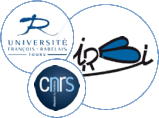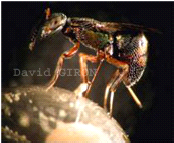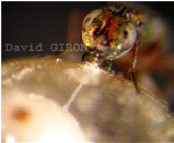








Ecophysiology and behavioural ecology of insects


2005-
2002-
1999-
Foraging ecology; Nutrients acquisition and allocation rules; Plant–insect interactions; Extended phenotype; Endophagous insects; Parasitoids; Leaf-




Desouhant E, Lucchetta P, Giron D & Bernstein C. (2010). Feeding activity pattern in a parasitic wasp when foraging in the field. Ecological Research 25 (2), 419-
Bel-
Casas J., Vannier F., Mandon N., Delbecque JP., Giron D. & Monge JP. (2009). Mitigation of egg limitation in parasitoids: immediate hormonal response and enhanced oogenesis after host use. Ecology 90, 537-
Giron D., Ross KG. & Strand MR. (2007). Presence of soldier larvae determines the outcome of competition in a polyembryonic wasp. Journal of Evolutionary Biology 20 (1), 165-
Giron D., Harvey JA., Johnson JA., Strand MR. (2007). Male soldier caste larvae are non-
Giron D., Kaiser W., Imbault N. & Casas J. (2007). Cytokinin-
Keasar T., Segoli M., Barak R., Steinberg S., Giron D., Strand MR., Bouskila A. & Harari AR. (2006). Costs and consequences of superparasitism in the polyembryonic parasitoid Copidosoma koehleri (Hymenoptera: Encyrtidae). Ecological Entomology 31 (3), 277-
Casas J., Pincebourde S., Mandon N., Vannier F., Pujol R. & Giron D. (2005). Lifetime multidimensional nutrient dynamics in a simultaneous capital and income breeding parasitoid insect. Ecology 86 (3), 545-
Giron D. & Strand MR. (2004). Host resistance and the evolution of kin recognition in polyembryonic wasps. Proceedings of the Royal Society London B 271, Suppl 6:S 395-
Giron D., Dunn DW., Hardy ICW. & Strand MR. (2004). Aggression by polyembryonic wasp soldiers correlates with kinship but not resource competition. Nature 430 (7000), 676-
Giron D., Pincebourde S. & Casas J. (2004). Lifetime gains of host-
Giron D. & Casas J. (2003). Lipogenesis in an adult parasitic wasp. Journal of Insect Physiology 49 (2), 141-
Giron D. & Casas J. (2003) Mothers reduce egg provisioning with age. Ecology Letters 6 (4), 273-
Giron D., Rivero A., Mandon N., Darrouzet E. & Casas J. (2002). The physiology of host feeding in parasitic wasps: implications for survival. Functional Ecology 16 (6), 750-
Rivero A., Giron D. & Casas J. (2001). Lifetime allocation of juvenile and adult nutritional resources to egg production in a holometabolous insect. Proceedings of the Royal Society London B 268 (1473), 1231-

Institut de Recherche sur la Biologie de l'Insecte
UMR 7261 Faculté des Sciences et Techniques
Avenue Monge, Parc Grandmont
37200 TOURS (France)


Main Research project
In spite of a reasonable understanding of the history and origins of the endophagous
feeding habit, its evolution and adaptive significance remains unclear. Three major
hypotheses have been proposed to explain the endophagous-
Publications list
Keywords :
Foraging ecology
Nutrients acquisition and allocation rules
Plant–insect interactions Extended phenotype Endophagous insects Parasitoids
Leaf-miners
Endosymbionts
Wolbachia
